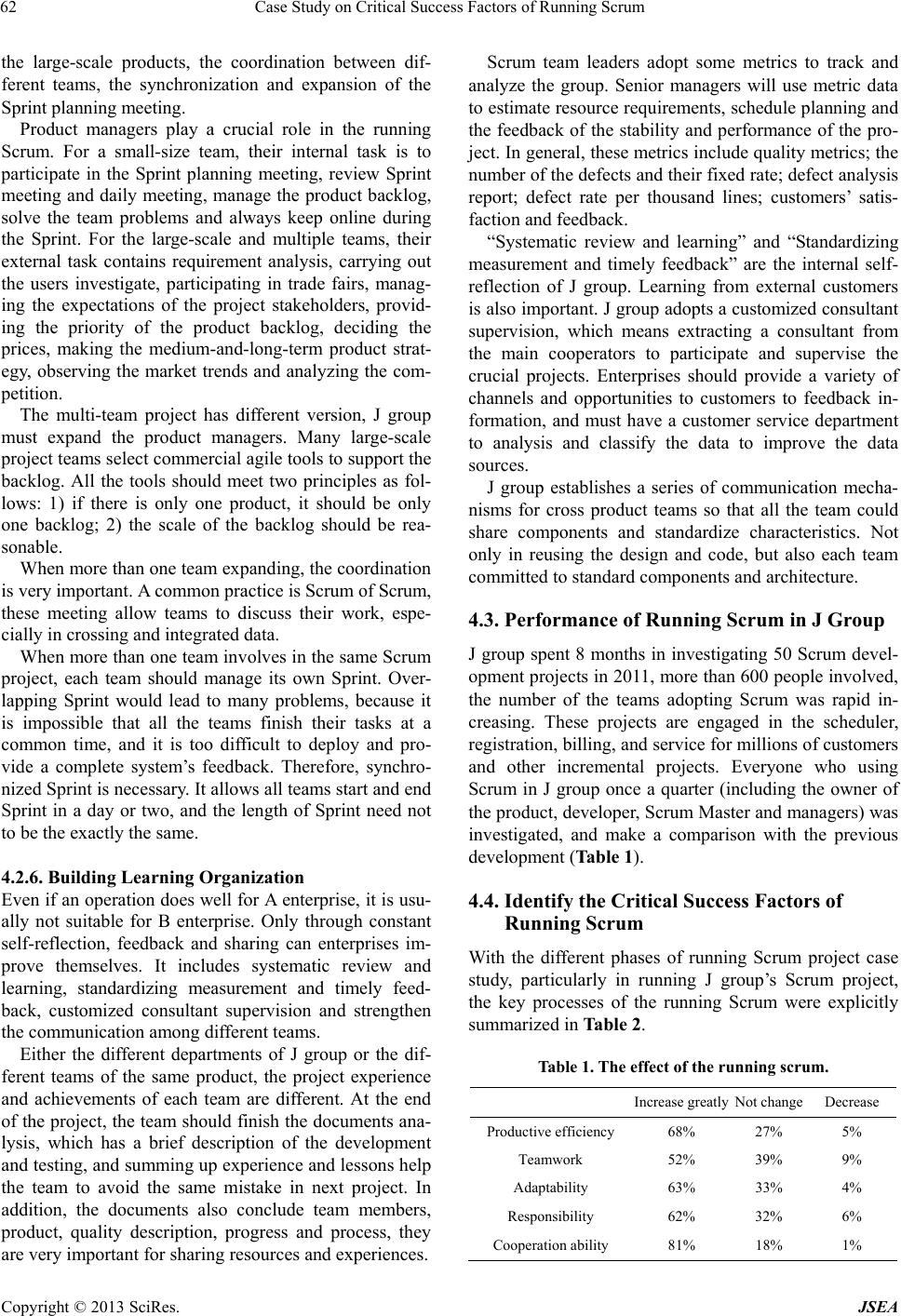
Case Study on Critical Success Factors of Running Scrum
62
the large-scale products, the coordination between dif-
ferent teams, the synchronization and expansion of the
Sprint planning meeting.
Product managers play a crucial role in the running
Scrum. For a small-size team, their internal task is to
participate in the Sprint planning meeting, review Sprint
meeting and daily meeting, manage the product backlog,
solve the team problems and always keep online during
the Sprint. For the large-scale and multiple teams, their
external task contains requirement analysis, carrying out
the users investigate, participating in trade fairs, manag-
ing the expectations of the project stakeholders, provid-
ing the priority of the product backlog, deciding the
prices, making the medium-and-long-term product strat-
egy, observing the market trends and analyzing the com-
petition.
The multi-team project has different version, J group
must expand the product managers. Many large-scale
project teams select commercial agile tools to support the
backlog. All the tools should meet two principles as fol-
lows: 1) if there is only one product, it should be only
one backlog; 2) the scale of the backlog should be rea-
sonable.
When more than one team expanding, the coordination
is very important. A common practice is Scrum of Scrum,
these meeting allow teams to discuss their work, espe-
cially in crossing and integrated data.
When more than one team involves in the sa me Scrum
project, each team should manage its own Sprint. Over-
lapping Sprint would lead to many problems, because it
is impossible that all the teams finish their tasks at a
common time, and it is too difficult to deploy and pro-
vide a complete system’s feedback. Therefore, synchro-
nized Sprint is necessary. It allows all teams start and end
Sprint in a day or two, and the length of Sprint need not
to be the exactly the same.
4.2.6. Building Learning Organization
Even if an operation does well for A enterprise, it is usu-
ally not suitable for B enterprise. Only through constant
self-reflection, feedback and sharing can enterprises im-
prove themselves. It includes systematic review and
learning, standardizing measurement and timely feed-
back, customized consultant supervision and strengthen
the communication among different teams.
Either the different departments of J group or the dif-
ferent teams of the same product, the project experience
and achievements of each team are different. At the end
of the project, the team should finish the documents ana-
lysis, which has a brief description of the development
and testing, and summing up experience and lessons help
the team to avoid the same mistake in next project. In
addition, the documents also conclude team members,
product, quality description, progress and process, they
are very important for sharing resources and experiences.
Scrum team leaders adopt some metrics to track and
analyze the group. Senior managers will use metric data
to estimate resource requirements, schedule planning and
the feedback of the stability and performance of the pro-
ject. In general, these metrics include quality metrics; the
number of the defects and their fixed rate; defect analysis
report; defect rate per thousand lines; customers’ satis-
faction and feedback.
“Systematic review and learning” and “Standardizing
measurement and timely feedback” are the internal self-
reflection of J group. Learning from external customers
is also important. J group adop ts a customized consultant
supervision, which means extracting a consultant from
the main cooperators to participate and supervise the
crucial projects. Enterprises should provide a variety of
channels and opportunities to customers to feedback in-
formation, and must have a customer service department
to analysis and classify the data to improve the data
sources.
J group establishes a series of communication mecha-
nisms for cross product teams so that all the team could
share components and standardize characteristics. Not
only in reusing the design and code, but also each team
committed to standard components and architecture.
4.3. Performance of Running Scrum in J Group
J group spent 8 months in investigating 50 Scrum devel-
opment projects in 2011, more than 600 people involved,
the number of the teams adopting Scrum was rapid in-
creasing. These projects are engaged in the scheduler,
registration, billing, and service for millions of customers
and other incremental projects. Everyone who using
Scrum in J group once a quarter (including the owner of
the product, developer, Scrum Master and managers) was
investigated, and make a comparison with the previous
development (Table 1).
4.4. Identify the Critical Success Factors of
Running Scrum
With the different phases of running Scrum project case
study, particularly in running J group’s Scrum project,
the key processes of the running Scrum were explicitly
summarized in Table 2.
Table 1. The effect of the running scrum.
Increase greatly Not change Decrease
Productive efficiency 68% 27% 5%
Teamwork 52% 39% 9%
Adaptability 63% 33% 4%
Responsibility 62% 32% 6%
Cooperation ability 81% 18% 1%
Copyright © 2013 SciRes. JSEA